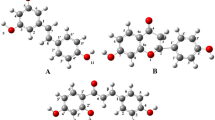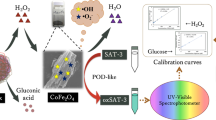We have used differential pulse voltammetry on platinum and copper cathodes to study the antioxidant activity of thiamine (vitamin B1) and its structural analogs. The results indicate that the activity of thiamine relative to the hydroxyl radical is lower than the activity of 3-benzyl-4-methyl-5-(2-hydroxyethyl)thiazolium chloride. At the same time, thiamine can more efficiently react with hydrogen peroxide and bind divalent iron ions.


Similar content being viewed by others
Notes
Evidence that the observed processes occur on the surface of the electrode comes from data on adsorption of the analyte compounds over the entire range of potentials.
References
R. Kluger and S. Rathgeber, FEBS J., 275, No. 24, 6089–6100 (2008).
L. Bettendorff and P. Wins, FEBS J., 276, 2917–2925 (2009).
N. Shangari, R. Mehta, and P. J. O’Brien, Chem. Biol. Interact., 165, 146–154 (2007).
A. A. Booth, R. G. Khalifah, P. Todd, and B. G. Hudson, J. Biol. Chem., 272, 5430–5437 (1997).
P. I. Lukienko, N. G. Mel’nichenko, I. V. Zverinskii, and S. V. Zabrodskaya, Bull. Exp. Biol. Med., 130, No. 9, 874–876 (2000).
I. L. Jung and I. G. Kim, Environ. Toxicol. Pharmacol., No. 3, 19–26 (2003).
Y. Okai, K. Higashi-Okai, E. F. Sato, et al., J. Clin. Biochem. Nutr., No. 40, 42–48 (2007).
G. S. Shapoval, V. F. Gromovaya, I. E. Mironyuk, and O. S. Kruglyak, Zh. Obshch. Khim., 78, No. 12, 2040–2044 (2008).
Y.-L. Hu, Y. Lu, G.-J. Zhou, and X.-H. Xia, Talanta, 74, 760–765 (2008).
F. Antunes, L. R. C. Barclay, K. U. Ingold, et al., Free Radic. Biol. Med., 26, 117–128 (1999).
M. Kessler, G. Ubeaud, and L. Jung, J. Pharm. Pharmacol., 55, 131–142 (2003).
I. E. Mironyuk, G. S. Shapoval, V. F. Gromovaya, et al., Teor. Éksp. Khim., 40, No. 2, 105–109 (2004). [Theor. Exp. Chem., 40, No. 2, 110–114 (2004) (English translation).]
A. A. Revina, P. M. Zaitsev, L. R. Sharifullina, and N. V. Bryantseva, Issledovano v Rossii [Russian electronic journal], 2563–2570 (2004).
G. D. Maier and D. E. Metzler, J. Am. Chem. Soc., 79, No. 16, 4386–4391 (1957).
J. M. El Hage Chahine, J. Chem. Soc., Perkin Trans. II, 4, 505–511 (1990).
Author information
Authors and Affiliations
Corresponding author
Additional information
Translated from Teoreticheskaya i Éksperimental’naya Khimiya, Vol. 47, No. 1, pp. 50–55, January-February, 2011.
Rights and permissions
About this article
Cite this article
Shapoval, G.S., Babii, L.V., Kruglyak, O.S. et al. Antioxidant activity of thiamine and its structural analogs in reactions with electrochemically generated hydroxyl radicals and hydrogen peroxide. Theor Exp Chem 47, 55–60 (2011). https://doi.org/10.1007/s11237-011-9185-y
Received:
Revised:
Published:
Issue Date:
DOI: https://doi.org/10.1007/s11237-011-9185-y




